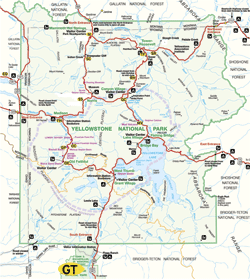 One day was spent traveling through Grand Teton National Park to Jackson
Hole. Along the way we drove over Jackson Lake Dam. The original dam in this
location was built in 1905-07, raising Jackson Lake above its natural level.
The modern dam is higher and impounds irrigation water for downstream use in
the Snake River Plain and to provide general flood control. The dam is designed
to
withstand
an earthquake of magnitude 7.5 on the Teton fault.
One day was spent traveling through Grand Teton National Park to Jackson
Hole. Along the way we drove over Jackson Lake Dam. The original dam in this
location was built in 1905-07, raising Jackson Lake above its natural level.
The modern dam is higher and impounds irrigation water for downstream use in
the Snake River Plain and to provide general flood control. The dam is designed
to
withstand
an earthquake of magnitude 7.5 on the Teton fault.
At scenic turnouts along the road to Jackson Hole you can see Mt. Moran, the northernmost of the high peaks in the Teton Range. The peak is made of 2.8 billion-year-old gneiss and 2.4 billion-year-old granites. The vertical diabase dike visible at the top 1.5 billion years old. Mt. Moran is crowned by the Flathead Sandstone, abaout 450 million years old. The vertical distance between the Flathead on the top of Mt. Moran and beneath Jackson Hole is aproximately 30, 000 feet. About 23, 000 feet of the uplift occured during the past 13 million years. The glacier visible near the top is one of the remaining active glaciers in the Tetons.
The day culminated in a trip to the top of Redezvous Mountain, elevation 10,450 ft., on the aerial tramway whose base is in Teton Village, Jackson Hole Mountain Resort. The Teton fault crosses the base of the mountain, covered by resort buildings. On the trip up the mountain, the first part of the trip crosses young aluvial fan deposits carried out by streams. Higher up is the 2.8 billion year Precambrian gneiss separated by an unconformity with sandstone, shale, and limestone. At the top, you have a good view of a cirque producted by a mountain glacier.
















